Slow Travel and Living in Palma de Mallorca, Spain
Article and photos by Paul Graham France
Resources updated 3/18/2024 by Transitions Abroad
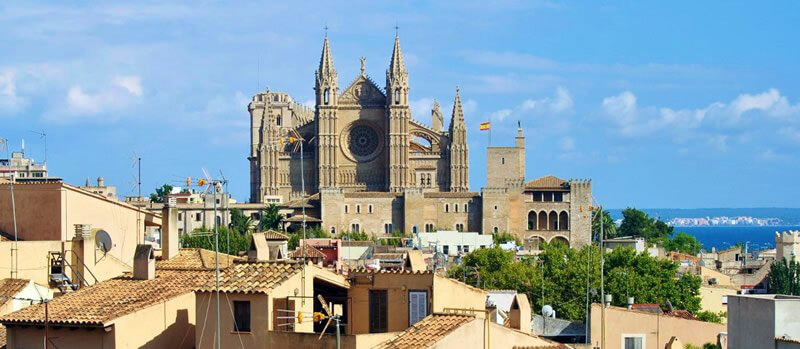 |
| A view of the stunning Le Seu Cathedral in Palma de Mallorca, Spain. |
Slow travel and the living movement motivate this traveler.
Unhurriedly absorbing our impressions with our five senses en route to a destination, you learn what's beneath the surface of a destination. You can observe local rituals, pick up mannerisms, and learn the local language, becoming a part of the local landscape and community instead of merely passing through. Traveling in this immersive way, you realize that the pleasure of travel lies in the experiences lived and observed along a journey that ends only when you wish.
Slowly absorbing five senses worth of impressions en route to a destination; learning what’s beneath the surface of a destination; observing local rituals, picking up mannerisms, and learning language(s); becoming a part of the local landscape and community instead of merely passing through. Traveling in this immersive way, you realize that the pleasure of travel lies in the experiences lived and observed along a journey that ends only when you wish it to.
Origins of the Slow Movement
"Slow travel," you ask? Briefly, it's part of a larger "Slow Movement" (inspired mainly by the Italian Slow Food Movement of the 1980s), consisting of a few essential principles or philosophies (exquisitely described in a piece titled A Manifesto for Slow Travel). The fundamental ideas are as follows:
- Getting there is half the fun. Travel slowly and multiply the depth of your experience.
- By land or by sea. Reduce flying if possible to better observe the details of the journey while keeping your carbon footprint smaller where possible.
-
When in Rome. Immersion in a culture and learning the local language(s) by listening and speaking to locals while contributing where possible to the community, rather than consumption travel involving a mad rush from one tourist attraction to the next.
- Those who have time have life. Whatever the length of your trip, try to get to know one place or region on a deeper level rather than cramming travel into snapshots to show off on social media.
Traveling Slowly South to Palma de Mallorca, Spain
I tested these ideas by practicing slow travel to the Spanish Mediterranean island of Mallorca, with its fascinating capital, Palma de Mallorca with its population of 400,000 people.
After three exciting years in Berlin, I had decided to leave the icy German winter in search of warmer climes and a different cultural experience — so I was off to Mallorca!
In the spirit of slow travel, I sought to go south beneath the clouds to enjoy a different perspective. While I find the gentle jostling and clickety-clack of train travel most relaxing and preferable, this journey called for a touch of the practical. Practical because a train trip of this distance would mean juggling timetables and incurring higher costs — fine for a grand European tour, but not so much for getting from point A to point B.
Note: If you travel by train across the continent, check out Railpass.
A Rideshare in Europe to the Rescue
Here is where the rideshare or carpooling form of transportation comes in handy. I have used the rideshare for years in Europe. While it's still lesser known, millions of Europeans use the option regularly. Few online ridesharing service providers existed previously, but in recent years, a big one has emerged called BlaBlaCar, and can hook you up with a ride throughout the continent.
The search feature is simple and safe. The payment is generally arranged and paid from the rider to the driver. Ridesharing, or "hitching" with others, works out cheaper than trains and even many flights. It is green and supports the Sharing Economy concept, as it explains as well on its blog.
Leaving Berlin, my new travel companions and I sit back and enjoy the experience of a genuine European road trip. Elke, our German driver, Alejandro of Barcelona, and I made our way south through Germany, Switzerland, and along the coast of France towards Barcelona. Spirits were high; conversation, storytelling, and tip-trading were interspersed with periods of silence and contemplation as we watched the countryside go by. We were an exceptionally compatible rideshare match. I've never had a "bad" experience. If that were ever to occur, there's always the window or a book to remedy any potential awkwardness.
Rideshare in Europe: BlaBlaCar.
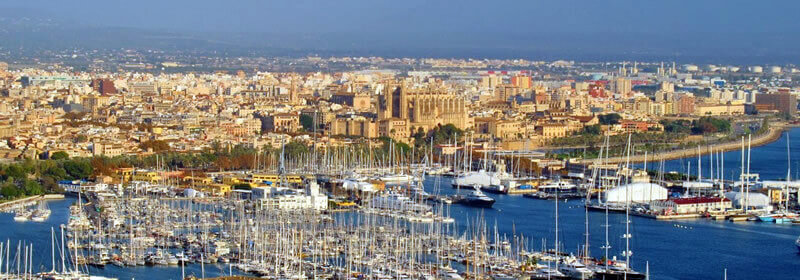 |
| Overlooking Palma Bay from Bellver Castle. |
Bienvenido en Palma
Greeting Mallorca in the sea breeze from the top deck of the ferry we had taken from Barcelona, feeling a gentle, soothing motion of buoyancy, we see the dazzling glint of the sun off the azure waves of the Bay of Palma. The iconic Gothic cathedral "La Seu" rises from the "Casco Antigua" old city center and dominates the panorama. As the ferry docks, the view — over moored, luxury yachts — reveals a city expanding from the old to the new, with a backdrop of mountains. Disembarking, my new companions and I reflect on the journey, exchange information, and say farewell in hopes of future meetings.
Apartment Shares
Now, where would I be staying? Naturally, much creative planning and research go into any slow travel journey — that's part of the allure. Nevertheless, being spontaneous can often open up interesting options as well. Either way, I prefer to plan my initial living situation as much as possible. Over the years, I have developed a personal travel planning formula, which has always worked quite well.
My formula starts with the Sharing Economy idea again. Temporary, private apartments or room rentals — like Airbnb, where a host offers a room or apartment to travelers or holidaygoers — have become more popular and, therefore, more plentiful online daily. With the first few days arranged at my host's beachfront apartment, I am free to explore Palma and look around for something more permanent while following up on some leads that I've found online in person.
Note: If traveling for a month or less, consider staying at the beachfront apartment example, though expect to pay considerably more than the local monthly rates.
Temporary apartment/room — international sites: AirBnB and VRBO.
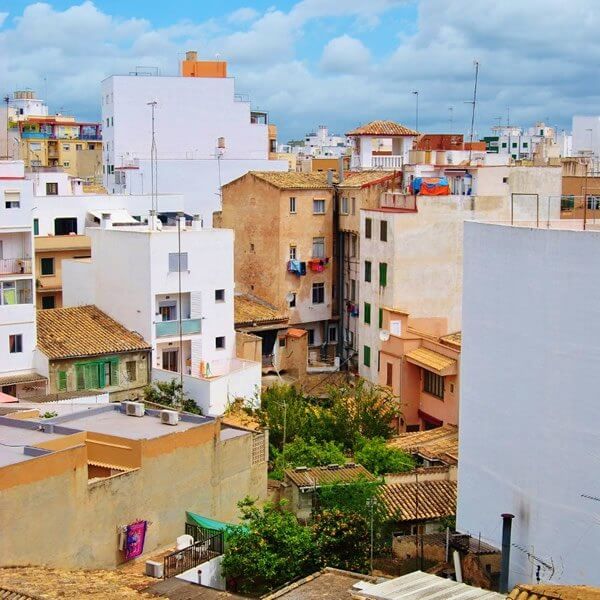 |
|
Finding an flatshare in Palma de Mallorca.
|
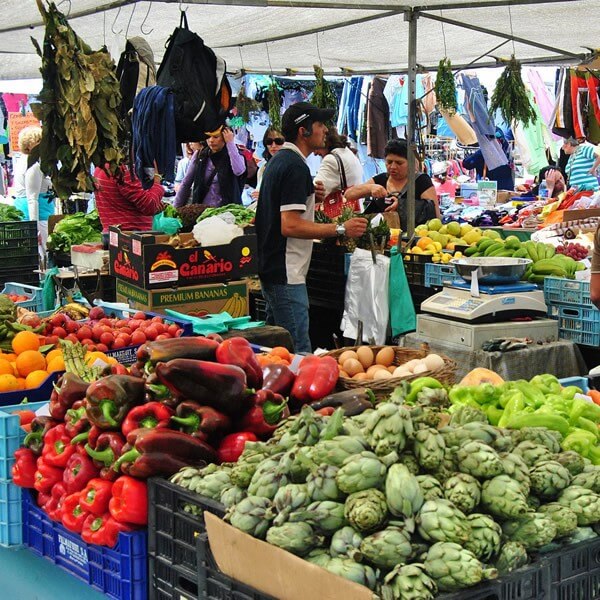 |
| A typical market in Palma de Mallorca where provisions for a meal may be found for a healthy and tasty meal light on the budget. |
Living with the Locals
in Palma de Mallorca
Strolling through the streets, plazas, and neighborhoods serves to begin your orientation and develop a sense of place. Ideally, you will aim to live in an area that feels good or interests you. You can then make any necessary compromises depending on your budget. Se Alquila ("For Rent") signs appear on many facades if you prefer your own place, most of which are furnished. Be prepared, however, to jump through some hoops, expect a lease, and plan on higher deposits and possibly fees.
There are a few reasons why living with locals in an flatshare is the way to go.
-
Rentals in an flatshare are considerably less expensive, as deposits are not always required.
- You have a home where you can cook, host guests, or merely relax and stay, which lightens your budget load.
- Living among locals gives one an inside view of the area and generally allows one to make new friends.
- Learn the language! Basic Spanish can be practiced with roommates, with shared feedback, before venturing out into the streets to speak with locals. You only have to resist the urge to speak a common non-Spanish language.
The web is the best source for finding a more permanent room. Several Spanish websites make searching a breeze. That's part two of my formula: use country-specific sites. Studying apartment terms is an excellent little Spanish lesson for browsing the offers for a flatshare or "piso compartido" before conducting the search process. I found an interesting prospect and sent an email to arrange a viewing. However, in Mallorca, at least calling directly (or using the mobile messenger WhatsApp) is more effective than email for meet-ups. In no time, I had moved in. I was ready to explore and acquaint myself with the new location and roommates and experience my continuing journey at the pace I had set.
I lived in two places for eight months to experience some variety.
First was a country finca (ranch house) named "Son Verger," on Palma's outskirts. Maria — my very "Mallorquin" landlady, who loved to talk about olden times (from what I could understand from her Catalan dialect), lived in the main house. I shared a flat/wing with a veteran Mallorca expat, Matthias, from Germany. We had our own vegetable garden, surrounded by olive and almond groves and the "Serra Tramuntana" mountains backdrop. Living in such a rural bliss was great for a while.
Later, I moved to Palma Center, where the action is (along with the nearby beach). My barrio (neighborhood) was incredibly ethnically diverse. Chinese, African, Indian, Arab, and South American people and shops were seen as frequently as Spanish. My roommates: Thomas, an Argentine expat; David, originally from Spanish Andalucía; Alba, a hippie artist from Italy; and I enjoyed many conversations (mixed English-Spanish-Italian) and dinner parties galore!
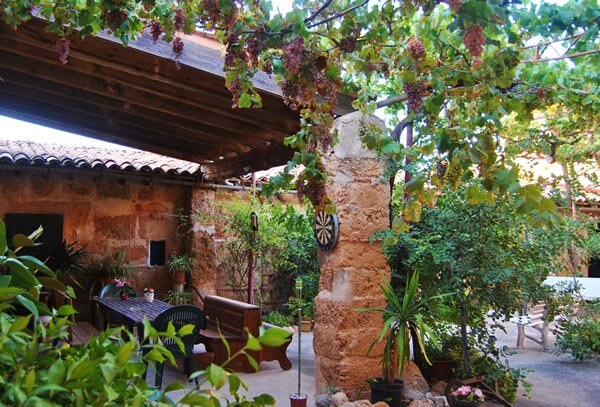 |
| A typical finca in Palma de Mallorca. |
Spanish apartment rental sites: PisoCompartido, Idealista
Reflections on Living in Mallorca
While relaxing on one of my many preferred beach spots, I reflect on these past months in Palma and Mallorca. Those mornings, I sat at a café on the neighborhood plaza ordering a "cortado" coffee with milk. I attempt to learn to make more and more sense from a newspaper. I have learned how best to navigate the local "Mercat Municipal" market by choosing fruit, vegetables, fish, or even a live chicken — fresh, inexpensive, and from the source.
My cooking has become more Spanish Mediterranean due to what's available here — with an Argentine dish, an Italian "intermezzo" there, and occasionally a spicy Andalusian paella — for home meals. Occasionally, I cannot resist the low-cost, ample meals at a neighborhood "cafetería," which offers the full spectrum of Spanish cuisine and a lively local atmosphere. For a quick snack, dropping into a tapas bar, which provides a variety of Spanish appetizers, will be what I miss most when I move on — especially "Bar Dia" in the narrow Carrer dels Apuntadors lane of the old city center.
I walk around differently now, greeting shopkeepers — like old Señor Llompart, whose still thriving, yet anachronistic knife-sharpening shop next door I pass to hear "hello inglés," and perhaps get a sharpening — or a passing neighbor on familiar routes through the city. I've gotten to know the place deeper, with all five senses, while making new friends, improving my Spanish, and traveling all over the island. Slowly, through immersion, I suppose I have become part of the local scene. I'd love to tell you more, but we're having a barbeque on our roof terrace tonight… hasta luego!
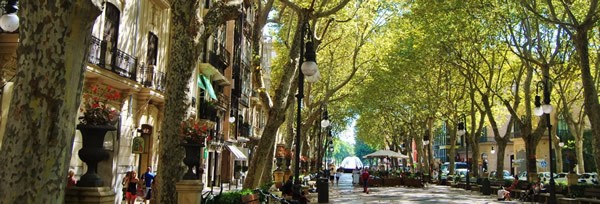 |
| A panorama of a quiet street scene in a Palma de Mallorca. |
Paul Graham France is a British-American nomad voyager who has traveled slowly across the planet thus far, including living in Germany, Spain, Costa Rica, and Brazil. He has been publishing articles, mostly on travel, since 2011 and dabbles in fiction. Current coordinates: Spain. |
